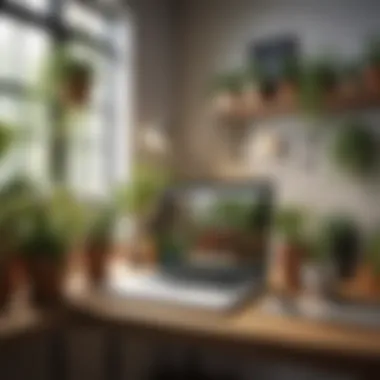Mastering the Art of Selling Indoor Plants: Your Essential Guide


Intro
Selling indoor plants requires a combination of passion and strategy. The growing trend of houseplants changes how people interact with their spaces. It creates a dynamic market, full of opportunities for those interested in selling. Identifying market trends is just the beginning. Sourcing and maintaining quality plants is crucial for building a successful business.
Understanding effective marketing approaches cannot be overlooked to attract the right customers. Legal aspects also impact the professional world of indoor plant sales, not to mention the funding and resource allocation.
This guide aims to delve into these details, promoting a thorough understanding necessary for entering this industry.
Market Trends in Indoor Plants
Current Trends
Indoor plants have surged in popularity, particularly due to urbanization and the shift towards greener living spaces. The Millennial and Gen Z demographics are particularly engaged with this trend. Sustainability plays a large role in this shift. Awareness about air quality and wellness encourages people to introduce greens into their homes.
Analyzing Demand
Analyzing what types of plants are trending is essential. For instance, trendy species like Monstera Deliciosa or Pothos can yield higher profit margins. Researching platforms such as Reddit and various social media gives insights into popular preferences.
Strategies for Sourcing Quality Specimens
Finding Suppliers
Reliable sources are key to maintaining quality. Local nurseries, well-established wholesalers, or trade shows can be excellent starting points for acquiring plants that meet market demands. Assessing the health of plants when making a choice is critical.
Maintaining Quality
Proper care needs attention. Implement regular inventory checks to identify issues promptly. Ensure optimal growing conditions and methods, focusing on moisture levels, temperature regulation, and adequate lighting through all sales channels.
Effective Marketing Approaches
Identifying Target Audience
Define the niche within the indoor plant community. Create customer personas that represent ideal consumers based on age, interests, and buying behaviors. Herahatiai experts suggest segmenting audiences further based on lighting needs, space requirements, or plant care difficulty.
Social Media Utilization
Using platforms like Facebook and Instagram allows one to showcase unique plant collections. Arranging digital events or lives can amplify reach significantly. Engaging content becomes a pillar for promoting your indoor plants.
Legal Considerations
Permits and Licenses
Understanding local regulations is crucial. Different states may have specific rules regarding the sale of plants. Researching and securing the right permits avoid penalties later on.
Shipping Regulations
If selling online, consider regulations affecting the shipping of certain plant species. Keep up to date on laws that require pest inspections or restrict certain plants across international lines.
“Knowledge about legalities could save considerable headaches both for newcomers and established sellers.”
The End
Selling indoor plants is more intricate than one may think. It encompasses skills from nurturing plants to understanding market psychology. However, mastering these areas often equates to successful sales. Fostering knowledge in sourcing, marketing, and legal frameworks lays the groundwork for a thriving indoor plant venture.
Understanding the Indoor Plant Market
The indoor plant market has experienced remarkable growth in recent years. Significant importance lies in understanding this market because successful sales depend heavily on current trends, buyer demographics, and competition. Market knowledge aids sellers in honing their strategies and ensures their products meet customer demands.
Current Trends in Indoor Plant Sales
The trend towards indoor plants is linked to a broader lifestyle shift towards health, well-being, and improved home environments. Consumers are gravitating towards air-purifying plants and low-maintenance varieties, which are especially appealing to busy individuals. Popular styles like minimalistic and bohemian interior design often highlight these plants, even making them statement pieces within spaces. Sellers should consider recent trends such as:
- Sustainability: Eco-friendly practices are becoming essential.
- Online Sales: The shift to e-commerce is fostering a growth in plant sales through social media and dedicated websites.
- Subscription Services: Regular deliveries of curated plants keep customers engaged.
This knowledge allows sellers to stock wisely and cater to current demands effectively.
Demographics of Indoor Plant Buyers


Understanding who is buying indoor plants is crucial for tailoring sales strategies. The demographics can vary significantly, but there are some common groups:
- Millennials: They prioritize aesthetics and sustainability, often sharing their plant passions on social media platforms like Instagram.
- Homeowners: This group tends to invest in decorative plants that enhance their living spaces.
- Urban Dwellers: Living in smaller apartments leads to a preference for compact plants.
- Eco-conscious Consumers: Also steadily rising in number, they prioritize plants which promote sustainability.
These insights help tailor marketing efforts and stock selections to resonate with specific buyer motivations.
Competition Analysis
A clear perspective on competition can dramatically influence sales strategies. Analyzing competitors allows sellers to discover market gaps and innovate products or services. This analysis can be structured as follows:
- Identify Key Competitors: Study major players like The Sill and Bloomscape alongside local nurseries.
- Product Offerings: Compare what competitors sell. Is there a focus on rare plants or common varieties?
- Pricing Strategies: Examine how pricing competes against others in the market.
- Marketing Approaches: Investigate which channels your competitors utilize for outreach and promotion.
“In-depth knowledge of your competitors can reveal untapped avenues for growth and innovation.”
Positioning against competitors requires acknowledging their strengths and weaknesses. Doing so positions sellers to not only meet but exceed customer expectations in a crowded market.
Sourcing Quality Indoor Plants
Sourcing quality indoor plants is a critical component in the success of any indoor plant business. Having healthy, vibrant plants directly contributes to customer satisfaction and, ultimately, profitability. Buyers are increasingly aware of the importance of quality when considering their purchase. Focusing on trusted suppliers, evaluating plant health thoroughly, and balancing costs effectively are essential strategies for anyone in the industry.
Identifying Reputable Suppliers
A crucial first step in sourcing quality indoor plants is to identify reputable suppliers. Potential sellers should look for established nurseries with good industry reputation. Certifications from agricultural authorities can offer additional assurances of plant health and quality. Feedback from existing customers also provides valuable insights. Prospective buyers might want to explore various sources such as plants importers or local growers, as both can present unique advantages.
Furthermore, networking within plant-selling communities can help in finding the right suppliers. Engaging in social media platforms like Facebook groups dedicated to horticulture can lead to opportunities for collaboration and connection with experienced sellers.
Evaluating Plant Health and Quality
Once suppliers are identified, evaluating the actual health and quality of the plants is next. This comparison is vital to ensure that one’s offerings meet customer expectations. Common indicators of plant health include:
- Correct foliage coloration
- Absence of pests
- Robust root structure
- Signs of disease or mold.
Potential buyers should also inspect transport conditions to ascertain that plants have not been compromised during shipping. IPM (Integrated Pest Management) procedures can help identify plant health issues before they arrive.
Plant quality significantly influences repeat customer rates. Therefore, making accurate assessments will position sellers positively in a competitive market.
Cost Considerations When Sourcing
Cost is always a pivotal factor when sourcing indoor plants. Knowing the full pricing landscape helps sellers balance their expenses and profits effectively. Some specifics to think about involve:
- Wholesale pricing versus retail pricing from suppliers
- Cost of shipping and transport
- Potential tariffs or charges if importing plants
It is advisable to build a budget that outlines all possible costs for sourcing plants. Adding a small buffer for unforeseen contingencies can help alleviate financial strain if supply bumps occur. Reviewing overall costs will allow for more informed decisions about which plants to actively source and deliver, ultimately influencing selling strategies.
Quality plants, competitive pricing, and healthy relationships with suppliers are keys to successful indoor plant sales.
Plant Maintenance and Care
Plant maintenance and care is a critical aspect of selling indoor plants. Understanding how to maintain plants directly contributes to the success of any seller. Well-cared-for plants are not only more appealing to buyers but also reflect the seller’s commitment to quality. Proper maintenance involves various elements including understanding watering schedules, light conditions and the correct use of fertilizers, ensuring that plants thrive.
Additionally, focusing on plant care boosts customer satisfaction. Customers often seek longevity in their plants—nothing disappoints a consumer more than a plant that does not live long. Hence, sellers must be able to provide appropriate care instructions. This trust can turn one-time buyers into loyal customers. Ensuring customers understand plant care also fosters community and repeat sales.
Essential Care Guidelines
Essential care guidelines encompass a variety of maintenance factors essential for the success of indoor plants. According to the type of plant, the level of light, moisture, and temperature can greatly affect overall health. Thus, it is important to provide comprehensive care instructions for different plant species. Here are key care considerations:
- Watering: Understand the specific water needs. Succulents require less frequent watering compared to tropical plants like ferns which may need constant moisture.
- Lighting: Different plants prefer different light levels, such as direct sunlight for cacti or low light for snake plants.
- Fertilization: Fertilizers provide needed nutrients, but it’s significant not to overfertilize, as this can harm the plants.
- Pruning Routine: Regular pruning helps maintain the shape of the plant and encourages new growth.
By managing these elements, sellers enhance the health of their plants, bst's customers.
Common Issues and Solutions
Dealing with plant health issues is a common occurrence whenever selling indoor plants. Common problems may arise from pests, diseases, or improper care. Identifying and addressing these issues promptly can save a plant’s life and improve sales on healthy specimens. Some frequent issues include:
- Pest Infestations: Common pests like aphids or spider mites can harm indoor plants. Often, insecticidal soap is effective for manageing pests.
- Overwatering: A prevalent issue leading to root rot. It's crucial for sellers to stress observing signs of overwatering.
- Leaf Yellowing: This can indicate various stresses like nutrient deficiency. Providing a balanced slow-release fertilizer can restore health.
Proper guidelines should be communicated to address these challenges.


Creating an Optimal Environment for Indoor Plants
Establishing an optimal environment is vital for plant growth. As indoor plants are often kept in artificial settings, replicating a natural environment is essential for their vitality. Here are steps to ensure optimal conditions:
- Humidity Levels: Many indoor plants favor higher humidity. Using trays filled with water and pebbles or humidifiers can improve indoor humidity levels.
- Air Circulation: Allow for adequate air circulation to prevent mold and mildew. Ensure that plants are not crowded together.
- Temperature Control: A comfortable temperature range of 65-75°F promotes growth.
When advising customers the evidence-based approach can yield successful results. Remember, it’s not just about making sales; it’s about lifting the overall market reputation of indoor plants sellers. When customers have healthy plants, they are more inclined to share their satisfaction with others, benefiting both the buyer and the seller long term.
Marketing Your Indoor Plants
Marketing is vital for the success of selling indoor plants. This field is both competitive and fast-evolving, making effective strategies essential. Using the proper marketing techniques can help to connect with your specific demographic while creating relevance for your brand.
Branding and Positioning
Branding is more than just a name or a logo. It is the emotion and perception associated with your indoor plant business. Developing a strong brand helps differentiate you from competitors in a saturated market. When positioning your indoor plants, consider what makes your offerings unique.
- Identify a niche, such as rare species, sustainable practices, or affordable options.
- Communicate a clear message that resonates with your target market. This message should reflect your values and provide added value to potential customers.
It's also crucial to ensure consistency across all platforms to build brand recognition.
Utilizing Social Media for Promotion
Social media presents an opportunity for cost-effective marketing. Platforms like Instagram and Facebook allow sellers to showcase their inventory visually, reaching a broader audience:
- Create visually appealing content. High-quality images that highlight the beauty of your plants can attract more engagement.
- Engage with your followers by sharing care tips and responding to their queries. This builds community around your brand and fosters loyalty.
- Run targeted ads. Social media advertising allows you to reach selected demographics more accurately.
Sales Platforms and Strategies
Understanding the right sales platforms and effective strategies is critical for anyone wanting to succeed in the indoor plant market. The right choice not only enhances visibility but also addresses the preferences of modern buyers. Potential sellers must consider how both personal interests in plants and business goals can align with various platforms.
E-commerce vs.
Physical Sales
E-commerce has revolutionized how goods, including indoor plants, are sold. Online sales offer a wider reach compared to traditional methods. Sellers can access a global market, and buyers can explore financing options and compare prices easily.
Some benefits of e-commerce include:
- Lower overhead costs
- Convenience for consumers
- Enhanced customer insights through data analysis
It is imperative to have user-friendly websites. For instance, detailed care guides and engaging plant trivia can encourage regular visitors. On the other hand, physical sales still hold value. They create tactile experiences, enabling customers to evaluate plant health. Shows and local markets cultivate community engagement. Physical presence can lead to immediate sales and cultivate long-term relationships based on trust. Tecnhiques such as workshops encourage participation and excite new customers.
Effective Pricing Strategies
Setting prices correctly can make or break a business. A balanced pricing strategy integrates costs, competitors’ prices, and perceived value. Competitive analysis is essential. It includes knowing the average price in the market, determining how prices fluctuate seasonally, and assessing whether plants offer premium features.
Consider offering:
- Discounts for bulk purchases
- Loyalty programs for frequent buyers
- Seasonal promotions that encourage buying during holidays
These approaches can stimulate demand while fostering customer loyalty. Understand the demographics of your audience; pricing strategies can differ based on preferences. Analyze whether casual buyers respond well to discounts or if enthusiasts appreciate exclusivity and quality.
Customer Engagement Techniques
Engagement with customers goes beyond a sale transaction. It embodies building relationships. Utilizing platforms like Instagram or Facebook allows sellers to showcase plants and educate kind of audiences.
Strong strategies include:
- Responding promptly to inquiries and comments
- Implementing regular newsletters filled with care tips or plant features
- Offering after-sale support to ensure customer satisfaction
Furthermore, creating interactive content such as polls on social media helps understanding customer preferences. Awards or giveaways can significantly boost both engagement and sales.
An engaged customer is more likely to recommend your brand and return for future purchases.
“Building relationships with customers is just as important as ur selling them the product.”


In this shifting landscape, leveraging diverse platforms and enriching the customer experience is vital for succeeding in the indoor plant sale business.
Legal and Regulatory Aspects
The intersection of the indoor plant market with legal and regulatory frameworks profoundly influences the operations of sellers. Every market has its complexities, and the indoor plant business is no exception. Understandably, navigating the legalities is crucial. Sellers need to comply with local regulations to maintain sustainable practices, ensuring safety and legality in their transactions enhances the trustworthiness of their business.
Understanding Local Regulations
Local regulations regarding selling indoor plants can vary widely. Sellers must educate themselves on horticultural laws in their area. This helps avoid unnecessary fines and penalties. Local governments may have regulations about the types of plants that are legal to sell. For instance, certain invasive species might be prohibited due to environmental concerns. Import and export regulations also come into play for those interested in acquiring plants from abroad. Regularly consulting local zoning laws and municipality brochures can be beneficial. Following these practices not only aligns with legal frameworks but also solidifies a seller's reputation within the community.
Licensing Requirements for Sellers
Licenses often serve as proof that the seller comprehends and adheres to the regulations governing indoor plants. Depending on the jurisdiction, sellers may need to obtain a business license or a specific seller’s license. These licenses help ensure that the seller is informed about sustainable business practices and customer safety. It would be wise to research licensing requirements during the initial planning phase of establishing a business. In some areas, sellers are required to demonstrate knowledge of plant diseases and pest management strategies as part of the licensing process. Consulting local authorities or agricultural extensions can provide clarification on necessary licensures.
Ensuring Consumer Safety and Compliance
Fostering consumer safety goes beyond just meeting licensing conditions. Sellers have a responsibility to provide quality plants. They must educate customers about how to care for them properly. Compliance with safety standards can often improve customer relationships and lead to repeat business. All sellers should have a grasp on relevant health standards concerning plant deliveries and disposal practices for non-viable plants. Ensuring that plants arrive free from pests is a segment of compliance that should not be overlooked. A reliable knowledge base on plant care and preventative measures can help in providing an insight thus enriching the whole experience for consumers.
Legal compliance in the indoor plant market safeguards not only the seller but also environmental sustainability and consumer health.
Sustainability Practices in Indoor Plant Sales
Sustainability is becoming increasingly important in the indoor plant sector. Consumers want to support businesses that show responsibility toward the environment. Therefore, adopting sustainable practices not only appeals to buyers but also contributes positively to the planet. As urbanization increases, our reliance on indoor plants grows to improve air quality and enhance aesthetic environments. However, increased demand must not escalate environmental damage. Thus, it is imperative that sellers understand and implement sustainability practices effectively.
Ethical Sourcing of Plants
Ethical sourcing of plants entails obtaining specimens from suppliers who prioritize environmental health and equity. This practice helps ensure that plants are grown without causes harm to ecosystems. Here are a few dimensions to consider when sourcing ethically:
- Choose suppliers who practice sustainable cultivation methods.
- Verifying the provenance of plants helps avoid contributing to deforestation.
- Supporting nurseries that adhere to fair labor practices protects workers' rights.
Sellers must engage with suppliers transparently discussing sourcing and production methods. Showing such dedication can differentiate a brand in the crowded market. Consumers are much more likely to support businesses that align with their values regarding sustainability.
Promoting Eco-Friendly Products
Promoting eco-friendly products goes beyond the plants themselves. This aspect involves endorsing accessories, pots, and fertilizers that follow sustainable norms. When sellers emphasize products that are biodegradable, recyclable or made from renewable resources, it attracts consumers mindful about their ecological footprints. Explicitly showcasing the benefits of eco-friendly options can convince cautious buyers.
For instance, highlighting that certain products release fewer chemicals can help bridge the gap for organic product preferences. Sellers should consider integrating marketing strategies that focus on educating customers about environmental impact:
- Utilize social media platforms to share sustainability initiatives.
- Host workshops on eco-friendly plant care.
- Develop informational pamphlets to guide consumers.
By creating awareness and promoting a greener option, sellers not only build trust with their clientele, but they also participate in enhancing the conscientious consumption culture.
Reducing Carbon Footprint in Operations
Reducing the carbon footprint in operations allows sellers to operate in ways that minimize environmental impact. Several measures can facilitate this goal:
- Streamlining logistics and distribution can decrease fuel consumption. Look for local sourcing options to decrease transportation emissions.
- Implementing energy-efficient practices in the workplace, such as using LED lighting or energy-efficient appliances, will lower energy usage.
- Reducing packaging waste through innovative designs can lead to decreased materials entering land fills.
- Consider using carbon offset programs to balance any unavoidably emitted greenhouse gases.
Minimizing carbon emissions is essential for long-term sustainability. Customers generally respond positively to businesses that demonstrate commitment to lower their environmental impacts, engendering more loyalty in an environmentally conscious audience.
By engaging in ethical sourcing, expanding the range of eco-friendly products, and actively working on lowering your operational carbon footprint, contributing positively to the indoor plant market is not only possible but necessary. Such practices lead to business sustainability while resonating with an increasingly aware customer base.
End and Future Directions
The indoor plant market shows promising potential for sellers, underscoring the need for strategic planning and reflection on one’s journey. Understanding the direction in which the market is heading is essential for adapting and thriving.
Summary of Key Points
In this guide, we have navigated the essential components of selling indoor plants, highlighting the following key points:
- Understanding Market Trends: Awareness of current trends can leverage opportunities for better sales and customer engagement.
- Quality Sourcing: Identifying reputable suppliers ensures the best plant quality that meets customer expectations.
- Essential Maintenance: Proper plant care not only enhances product quality but also builds trust with customers, as they often seek guidance.
- Effective Marketing: Exploring avenues such as social media promotion and an online presence will broaden reach.
- Regulatory Knowledge: Comprehension of legal aspects keeps sellers compliant, ensuring trust and safety for both seller and buyer.
- Sustainability Practices: Employing eco-friendly techniques boosts appeal to environmentally conscious clientele.
"Adaptation and continuous learning are as vital in business as photosynthesis is for plant life."
These elements converging form the backbone of a successful indoor plant business.
Trends to Watch in the Coming Years
Looking ahead, sellers should watch for several significant trends that could shape the indoor plant market.
- Rise in Online Shopping: Consumer habits are shifting towards e-commerce, especially post-pandemic. Establishing a strong online store can tap into this market.
- Increased Focus on Wellness: The growing awareness of wellness is driving more people to incorporate plants into their homes for mental health benefits. Sellers can emphasize these aspects in their marketing.
- Local Sourcing and Sustainability: Consumers increasingly care about how products are sourced. Ethical sourcing practices can enhance brand loyalty.
- Diverse Plant Offerings: There's a notable uptick in demand for rare and unique species. Offering a varied range can attract succulent enthusiasts and aspiring collectors.
- Integration of Technology: AR applications for plant placement and care tips can enhance customer experience and engagement, adding value to the purchase.
Overall, staying attuned to these trends can bolster sales strategies and enhance market connectivity, ultimately contributing to the success of any indoor plant business.







